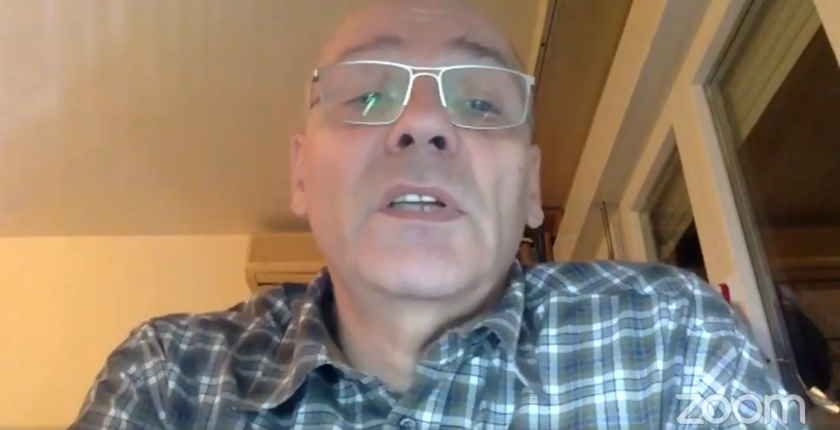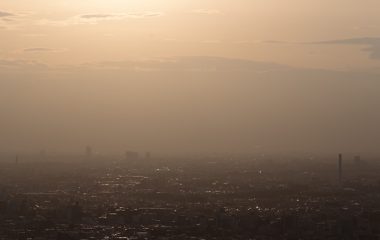
Brezanska river (photo: Predrag Ilić)
Author: Iskra Krstić
Ten small hydropower plants have already caused great damage to the area around the city of Kraljevo between the mountains of Goč and Golija, evident from the devastation of rivers and animal species, primarily trouts. But the situation could get worse as the city’s spatial plan envisages the construction of another 42 small hydropower plants and a ski center on Golija.
The Right to Water initiative held a lecture and discussion on nature protection in the region and the harmful impact of run-of-river small hydropower plants. The event was named “Gambling with nature has no winners – Kraljevo, Goč, Golija and SHPPs.”
The importance of the area for environmental protection and the preservation of nature in the Balkans and Europe is evident, as it hosts special nature reserve Goč-Gvozdac, nature park Golija and biosphere reserve Golija-Studenica, with habitats of hundreds of species of birds and fish, including protected plants and animals.
According to activists from the Right to Water, the value of the watercourses is not only in natural resources, but in their significance for the people who live nearby and use them for water supply, livestock and field irrigation or for other activities such as sustainable tourism, hiking and recreation.
The event was organized as part of international campaign Save the Blue Heart of Europe, and the recording is available here.
Derivation SHPPs have reduced the trout population by 90% on every location

The first panellist was Professor Predrag Simonović from the Faculty of Biology at the University of Belgrade, who has been studying habitats and the effects on fish stock for over twenty years. He and his colleagues from the faculties of biology and forestry have been collecting data on trout stock in mountain rivers in Serbia and their protection since 1998.
Serbia has a relatively small territory, but also great importance for the preservation of several types of brown trout that live in it, the professor explained. Unfortunately, it is the most endangered by the harmful effects of SHPPs of all fish species in Serbia.
Even compliance with statutory procedures does not play a role in preserving fish stocks
“Research has shown that derivation SHPPs have reduced the trout population by 90% in each trout habitat on which they are built,” said Simonović, adding that compliance with statutory procedures does not play a role in preserving fish stocks, as the ecosystem the rule is violated.
Simonović explained the mechanism of trout habitat disturbance based on data from research he conducted last year on several rivers in the vicinity of Kraljevo and Arilje, together with colleagues Dr. Vera Nikolić, Dr. Ratko Ristić and Dr. Vukašin Milčanović. It involved the Gokčanica, Kolska, Sokolska and Brezanska rivers, as well as Jošanica and Panjica.
Small hydropower plants, it was shown, have the same effect on temperature, oxygen and electrical conductivity, i. e. the solubility of substances of all the rivers on which they are built: water temperature downstream from the derivation is always higher than above the water intake, while the amount of oxygen is higher above hydropower units.
Fish paths are useless for domestic trout, which unlike the Atlantic ones do not have a migratory instinct and do not enter them
The most drastic change is in the amount of dissolved substances, of which there are more below the derivation. In simple terms, a small amount of water remains in the watercourse outside the pipeline and heats up faster (which is why it loses oxygen) and flows more slowly – which is why the composition of the water changes faster.
Simonović also presented pictures from the field to the audience, in order to draw attention to obvious problems. In the Kola river, about six times less water remains outside the pipe than in it, and the fish path, although built according to regulations, is unusable for fish in practice. Furthermore, domestic trout couldn’t use most of the fish paths, the construction of which requires a more serious scientific and technological approach, unlike the Atlantic ones, which have a migratory instinct.
“Our trout move about a hundred meters up and down,” which makes that compensatory mechanism meaningless for the losses in the population caused by SHPPs.
The other compensatory mechanism, restocking, is no better. For the purpose of restocking, for example, a unique hatchery was built, with the intention of restocking all endangered rivers in Serbia with trout. However, “each trout gene pool adapts to the local river and may be quite different from the gene pool of the first neighbouring river,” a value that is lost through restocking.
Simonović also stated that private financial interests are most oftenly behind such, obviously illogical decisions.
EIAs are written by civil engineers

He also pointed to the lack of studies on environmental protection and the lack of quality studies.
“Hydropower plants were built on rivers that have a maximum flow of just one hundred to four hundred liters of water per second, with such a small installed capacity that they do not legally require environmental impact studies. The intention was to destroy waters that are extremely valuable in every sense (including their value as drinking water reserves), in order to achieve personal, material gain,” Simonović asserted.
Simonović criticized some of the rare studies of the impact of SHPPs on the environment that were conducted and that are available.
In a study on one SHPP in Golija, an unfounded conclusion is made that “trout will live better in deeper water.” The document wasn’t signed by a biologist, but a civil engineer. In the Hydroecological Study on the Possible Impact of SHPP Lanište on the Ecosystem of the Rupska river, a biologist is of the opinion that “trout will grow faster and live better in a smaller amount of water, left in the riverbed after a part of the river is diverted into a pipe, because they will suffer less and spend less energy on swimming,” stating that the population would not drop “below the optimal reduction in the number of trout,” which the professor warned is a formulation that does not exist in theory.
The construction of the ski resort requires the destruction of a centuries-old forest

Milan Ružić from the Bird Protection and Study Society of Serbia introduced the audience to the specifics of Golija mountain. According to him, it is one of the few mountains in Serbia remaining with a large number of settlements where inhabitants are engaged in traditional activities: forestry, livestock breeding, fruit growing. Since it is also extremely rich in forest and water, Golija is attractive for rural tourism throughout the year, and it could be a hub for the return to the traditional way of life for those who would like to.
Instead, Golija is exposed to intensive forestry, illegal construction and the danger of the construction of a ski center.
“Building the infrastructure for a ski resort would require the destruction of a centuries-old forest with the most valuable species that we have on our mountains,” Ružić explains. They seek shelter in coniferous, cold forests, of which there are only a few in Serbia, he added. “If they lose their habitat, we lose them permanently.”
On what grounds are building permits issued for a nature park?
In addition, due to climate change, there is not enough natural snow on Golija, so it would have to be made artificially. In practice, it would require most springs and rivers to be captured and diverted to artificial reservoirs. Due to the deforestation and disruption of watercourses, habitats would be drastically fragmented, animals would be disturbed by the accompanying traffic, and the environment would be damaged by waste like in other ski resorts in Serbia.
Ružić pointed out that Golija was under attack by illegal construction and asked whether it is possible and how to issue building permits in a nature park: “We have lost Kopaonik, Zlatibor has been turned into a new Dorćol or Budva, and we are losing Golija right in front of us.”
Competent institutions, faculties, institutes are silent about the devastation of Golija
The representative of the Bird Protection and Study Society of Serbia also stated Golija suffers from intensive forestry as well, often without consideration for the ecological function of the forest. He criticized the practice of removing dry wood from the forest as it has an important role in restoring ecosystems. Namely, dry wood is irreplaceable in the food chain and provides a home for various groups of organisms, including birds, and by removing dead trees, the habitats of the most endangered bird species, such as owls and woodpeckers, disappear.
Ružić also criticized competent institutions, faculties and institutes, with the exception of the Faculty of Biology, for not taking a public stand against the devastation of Golija.
Former bison habitat
Pavle Pavlović, a tour and mountain guide, revealed a little-known fact to the audience, that Golija is spread over five units of local self-government: two cities and three municipalities.
He agreed with Ružić in the assessment of the current situation on the mountain and the greatest threats to its ecosystems. Pavlović presented photo documentation of the natural beauties of Golija to the audience, with an emphasis on watercourses and water surfaces: the Studenica river tributary called Izubra, a former bison habitat, river Brevina, the Košenovo lake, in which triturus still survives, the lakes of Veliko and Daićko and others.
Pavlović commended the activities of the management of the nature park and forest management firm Srbijašume for researching the nature in Golija where, among other things, two previously unknown lakes in the village of Kuti were discovered.
Increase of surcharge paid by electricity consumers to fund renewable energy incentives is disturbing news

Bojana Minović, an activist of the Let’s Save the Mountain Rivers of Kraljevo initiative, mostly focused on a visual presentation of the destruction of rivers with the construction of small hydropower plants. She highlighted several examples of the devastation of watercourses including the Brevina river and the aforementioned Sokolska, Gokčanica and Brezanska rivers.
Minović said she was struck by how all the beauty of the rivers disappears together with the memories of everyone who knew them.
A crime against nature has occured on Brezanska river
“The Brezanska river used to be the pride of the mountaineers of the Kraljevo area,” she added and explaining they are in despair because of “the crime against nature that happened there,” the disappearance of animal species and the disturbance of the landscape.
During the conference, the audience learned the news that the surcharge paid by electricity consumers to fund renewable energy incentives has increased fivefold.
“Considering that in the past six years Serbia has spent around EUR 105 million on such subsidies for energy from renewable sources, most of which unfortunately went to small hydropower plants with derivation, this is alarming news,” Iva Marković from the Right to Water initiative warned.
Citizens are excluded from work on the new cadastre of small hydropower plants
Locals are not sufficiently informed about the problems that have been discussed. For example, few people apart from experts know that a new cadastre of small hydropower plants and a new spatial plan of the Republic of Serbia are being drafted. The public should also participate in the process.
In the final part of the event, the participants discussed how they imagine the transition to renewable energy sources, since the policies that are being defined today will have far-reaching consequences.


















Be the first one to comment on this article.